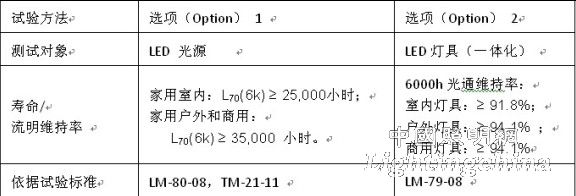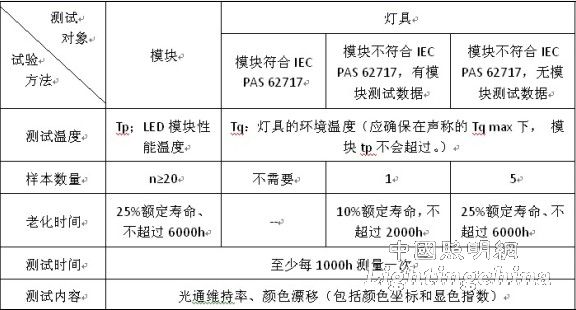1 Overview
With the continuous improvement of LED light efficiency in recent years, the life and reliability of LEDs have received more and more attention from the industry, and it is one of the most important performances of LED products. Lifetime is the ultimate performance of reliability. However, the theoretical life of LED is very long. Like the traditional light source, the cycle test of 2h45min and 15min is used to end the life. The measurement of LED products is obviously unrealistic. Therefore, it is necessary to adopt accelerated aging life test for LED products [1]. At the same time, it should also test the thermal properties, environmental weather resistance, electromagnetic compatibility immunity and other properties closely related to life and reliability, in order to comprehensively analyze LED. life.
2. LED reliability and life related key indicators
Every component and link in the manufacture of LED products has an impact on its reliability and lifetime, such as the solder joints of LED junctions and substrates, the thermal quenching and degradation of LED phosphors, the degradation of packaging materials, and the failure of drivers. The final possibility of degradation is the semiconductor (PN junction) itself. These factors lead to LED product failure (degeneration) in different ways, generally can be divided into gradual degradation and abrupt degradation.
LED's graded degradation (failure) indicators mainly include:
The lumen maintenance rate decreases, that is, the light decay, generally with an initial luminous flux of 100%. When the lumen maintenance rate of the LED product drops to 70% or 50% of the initial value, the LED is considered to be ineffective, and the lumen maintenance life is correspondingly recorded as L50 or L70;
Color drift, subject to changes in phosphor or packaging materials, the color of the LED will drift during the lifetime, the drift should be within the specified range (such as Δu'v' ≤ 0.007), beyond the range is considered LED failure;
Changes in electrical properties, electrical performance changes can be monitored more intuitively;
The number of switches, the switch may have a certain impact on the drive and other circuits;
Thermal resistance changes and other thermal characteristic parameters, thermal characteristics are closely related to life, and measurement and analysis of thermal characteristics can help identify weak links in LED reliability;
LED transient degradation (failure), that is, the LED light output suddenly drops to 0, its main degradation includes: anti-electromagnetic interference capability: electrostatic discharge, lightning surge, fast group pulse, cycle drop; high and low temperature impact tolerance characteristics; Salt spray, moisture resistance, vibration, etc.
3. Relevant standard requirements
In view of the main slow-degradation of LEDs, relevant standards have been released in the world, so that the North American system and the International Commission on Illumination (IEC) system are the most typical, and the Chinese standards basically combine these two systems.
• ENERGY STAR® Program Requirements Product Specification Eligibility Criteria ;
• IES LM-80-08 Approved Method for Measuring Lumen Maintenance of LED Light Sources;
• IES TM-21-11 Projecting Long Term Lumen Maintenance of LED Packages
• IEC/PAS 62717 LED modules for general lighting – Performance requirements
• EC/PAS 62722-2-1 Luminaire Performance – Part 2-1: Particular requirements for LED luminaires
• China's GB/T 24824, GB/T24823, QB/T4057, etc.
• China's GB/T XXXX LED accelerated life test method (not yet released)
3. Requirements for LED life and life test methods for North American systems and IEC systems
North American systems and IEC systems differ in terms of life requirements and test methods for LED products, but for the evaluation of LED lamp life, both propose direct aging test lamps, or aging tests based on packaged LEDs, LED modules, etc. Make a calculation.
3.1 North American System
As shown in Table 1, Energy Star will divide the test method for LED lamp life into Option 1 and Option 2, where Option 1 is to derive the life of the lamp through the test source; Option 2 is only applicable to the integration of the source and the lamp. The luminaire directly tests the lumen maintenance of the luminaire. The expression of option 1, L70 (6k) refers to the time that lumens are maintained by the 6000h (6K) aging test to maintain the lifetime L70.
Table 1: US "Energy Star" requirements for LED lamp life


The requirements for the two standards of LM-80 and TM-21 are summarized as follows:
Scope of application: LED package, module, array, etc.;
Object of investigation: only investigate the maintenance of the life of the light, that is, the slowing failure factor
Aging temperature: The specified case temperature (Ts) is 55 ° C, 85 ° C and the third specified temperature, and the three temperatures cover the Ts temperature of the LED light source in the lamp.
Aging time: 6000h, recommended 10000h;
The number of samples required and its relationship with the extrapolated life time: more than 20 samples, the extrapolated life is up to 6 times the aging time; 10-19, the extrapolated life is up to 5.5 times the aging time;
Light color parameter test time: at least every 1000h;
Treatment of sudden failures: observation records, investigations confirm that sudden failures are due to the source itself;
Record color decay: yes;
Data record: lumen maintenance, median, standard deviation, minimum and maximum lumen maintenance values ​​for each LED;
Curve fitting: 1. Normalize the luminous flux maintenance rate with an initial value of 1;
2. At each measurement point, obtain the average of the normalized values ​​of the test samples;
3. Data requirements: Do not use measurement data less than 1000h; aging 6000h-10000h, use at least 5000h of data; greater than 10000h, use the last 50% of data.
Extrapolation calculation: Recommended index model.
3.2 IEC system
Lx Fy is used in the IEC system to characterize the lifetime of LED products. Lx represents the luminous flux maintenance rate, such as L70; Fy represents the failure rate, including the slow failure rate By and the transient failure rate Cy. For example, if the L70F50 is 30000h, it means that the lumen maintenance rate of 50% of the modules after 30000h is 70% or less.
For white LED products for general lighting, the IEC does not emphasize the verification of the claimed life, but the grading of the lumen maintenance rate for a limited time.
The lumen maintenance test for LED modules and luminaires in the IEC is shown in Table 2. Special attention is paid to the transient failure and slow-change failure of LED modules or luminaires in the IEC system to be reflected in the final Fy indicator. For a group of LED modules, according to 20 test samples, if F50 is claimed, at least n-2 modules pass; if F10 is claimed, all n modules pass the test.
The temperature in the aging test is also of particular concern. LED module aging should be aged at the specified point of the housing at Tp temperature, equivalent to Ts in the North American system; and the luminaire should be tested for its performance at ambient temperature Tq, and should ensure that the module temperature Tp does not exceed the claimed Tq max .
